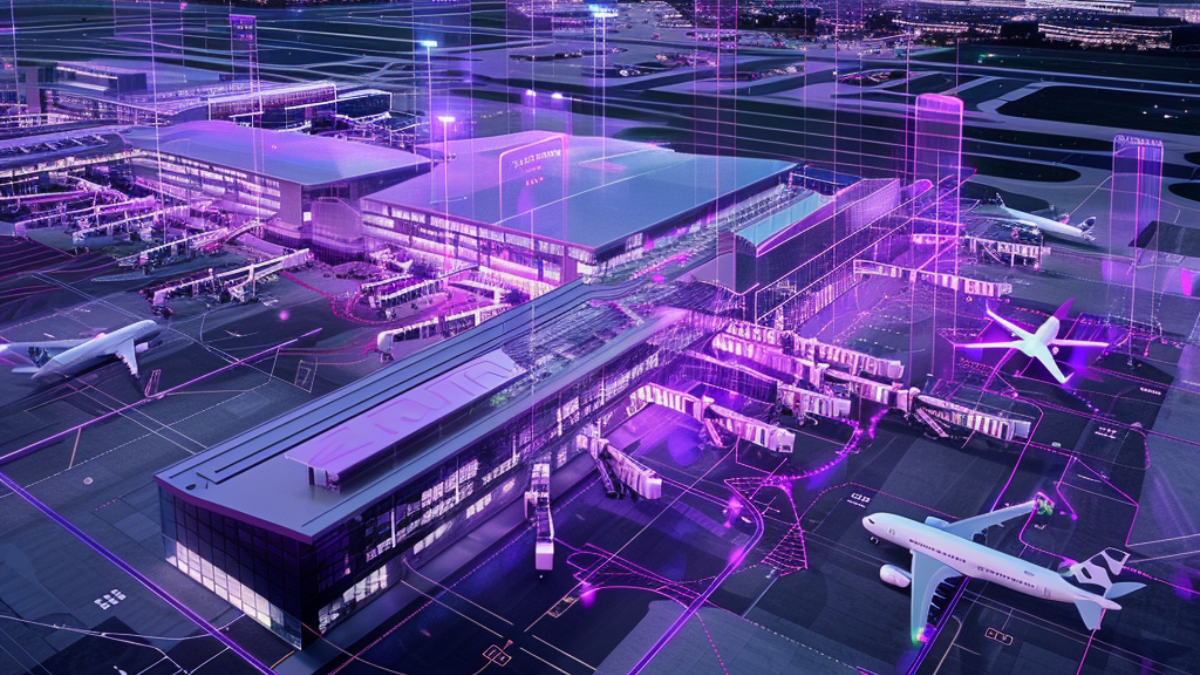26 Mar 2024 | Industry Insights
Revolutionising Airports with Digital Twins: A Flight Towards Innovation and Efficiency

Revolutionising Airports with Digital Twins: A Flight Towards Innovation and Efficiency
In an era where efficiency is appreciated and expected, the aviation sector stands at the forefront of embracing cutting-edge technologies to enhance operational capabilities. Among these technologies, Digital Twins emerge as a beacon of innovation, offering a dynamic, virtual replica of physical assets, processes, and systems. While seemingly futuristic, this concept rapidly becomes indispensable for process optimisation across modern industries, including aviation.
Digitalising the Tarmac for Improved Maintenance
The most critical asset of an Airport is its tarmac, where a defect could result in passenger delays, severe schedule disruption, and potential risk to passenger safety.
So imagine being able to divide an airport's tarmac into detailed, manageable sections, each with its digital counterpart within your Digital Twin.
By digitalising the physical tarmac in a virtual model, airport management can pinpoint areas requiring immediate attention, run scheduled maintenance plans and analyse if any areas of the tarmac have had an unusually high number of defects registered over 12 months, ensuring operational safety and efficiency.
This segmentation approach allows for a proactive stance on maintenance, significantly reducing the risk of unforeseen issues that could lead to costly downtime.
Improved People Management for Reduced Waiting Times
Airports are more than just points of departure and arrival; they are bustling hubs of activity where time is of the essence. The importance of efficiently managing people's movement cannot be overstated.
Digital Twins offer an unparalleled advantage by providing real-time tracking of passenger flows throughout the terminal, using non-intrusive technology such as BLE beacons to monitor across the airport.
This data enables airlines and airport management to better observe and optimise passenger channelling, significantly reducing wait times and enhancing the traveller experience by identifying bottlenecks within the airport ecosystem.
The functionality of real-time people movement could also improve security by identifying unusual patterns or unexpected movements in restricted areas.
Reducing Downtime of Retail and Lounges Through Predictive Maintenance
The scope of Digital Twins extends beyond the tarmac, infiltrating every corner of the airport's operations, from retail stores to restaurants and exclusive lounges.
By plugging into Digital Twins' predictive maintenance functionality, facilities managers can create simple workflows to identify potential maintenance issues before they escalate, ensuring that every service within the airport precinct operates with limited interruptions.
This predictive capability minimises downtime of tenant spaces and elevates the passenger experience by ensuring that all amenities function optimally.
Optimised Energy Management to Aid Decision-Making
Airports are 24/7/365 operations, and they need to create a safe, well-lit, and welcoming environment for passengers and airport staff. Along with the continued technological advancements to support baggage handling, security, airport signage, and the potential future of electric and hybrid aircraft, airports must optimise their energy consumption.
Digital Twins allow airport management to analyse not just overall airport energy consumption trends but also narrow them down to areas, systems, or even individual assets to create a holistic view of energy performance and cost.
When this is combined with a smart CAFM system, you can cross-reference energy performance with asset performance and maintenance hours to drive smarter, data-driven decision-making.
The Takeoff of Efficiency and Innovation
Digital Twins represent more than just a technological advancement; they embody a shift towards smarter, more efficient airport operations. By integrating this technology, airports can anticipate challenges, streamline processes, and, ultimately, provide a superior experience for travellers. The applications of Digital Twins in the aviation sector underscore a commitment to innovation, setting a new altitude for operational excellence.
In conclusion, as we navigate the complexities of modern-day travel, adopting Digital Twins in the aviation sector is a testament to the relentless pursuit of efficiency and improvement. By harnessing the power of this technology, airports worldwide are not just preparing for the future; they are actively shaping it, ensuring that every journey begins and ends on a note of unparalleled excellence.
Join us on this transformative journey and discover how Digital Twins are setting a new standard for airports worldwide.

eBooks
Digital Twins Simplified
Discover the world of digital twins in a whole new light with our eBook, Digital Twins Simplified! Specifically tailored for construction enthusiasts and professionals, this comprehensive guide demystifies the concept of digital twins, breaking it down into easily digestible insights. Uncover the transformative potential of this cutting-edge technology as you explore real-world applications, benefits, and strategies to revolutionize your construction projects.
Read more

eBooks
How to Create a Digital Twin Strategy
In the era of digital transformation, businesses across various industries are leveraging innovative technologies to enhance their operations and drive growth. One such groundbreaking technology is Digital Twinning. However, to truly harness its potential, a well-thought-out digital twin strategy is vital. This is where our latest PDF - "How to Create a Digital Twin Strategy", part of the Demystifying Digital Twins series, comes into play. This detailed guide is designed to provide you with a clear roadmap to establish a successful digital twin strategy that can significantly impact your business outcomes.
Read more

eBooks
Digital Twins in Action: Unveiling the Best Use Cases for Buildings and Infrastructure
Understanding the diverse use cases of digital twins is paramount to unlocking their full potential. In this eBook, we will explore many use cases showcasing the versatility and efficacy of digital twins across different domains. From optimising energy consumption in buildings to ensuring the resilience of critical infrastructure.
Read more
Book your one-on-one appointment with one of our specialists.
info@twinview.com
+44 (0)844 800 6660
London
24 Greville Street
Farringdon
London
EC1n 8SS
Newcastle
Spaceworks
Benton Park Road
Newcastle upon Tyne
NE7 7LX

